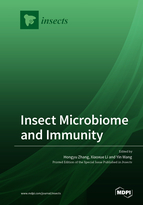Insect Microbiome and Immunity
A special issue of Insects (ISSN 2075-4450). This special issue belongs to the section "Insect Behavior and Pathology".
Deadline for manuscript submissions: 25 April 2024 | Viewed by 26036
Special Issue Editors
Interests: insect microbiome and molecular biology
Interests: Insect innate immunity and inter-organ communication
Special Issue Information
Dear Colleagues,
Insects comprise the most diverse groups of organisms and live in diverse environments. As with all other organisms, insects encounter a wide range of microbes. While they rely on the innate immune system to combat these invading microbes to maintain homeostasis, some microbial communities of the insect microbiome can benefit the host and profoundly affect host physiology and overall fitness. Microbiotas have been proven to provide nutrients, promote host defense, and mediate host reproductive behavior. In recent decades, the emergence of high-throughput sequencing has enabled researchers to study host–microbe interactions from the whole microbiome level rather than single microbial species, greatly expanding our knowledge of insect biology.
Prof. Dr. Hongyu Zhang
Prof. Dr. Xiaoxue Li
Dr. Yin Wang
Guest Editors
Manuscript Submission Information
Manuscripts should be submitted online at www.mdpi.com by registering and logging in to this website. Once you are registered, click here to go to the submission form. Manuscripts can be submitted until the deadline. All submissions that pass pre-check are peer-reviewed. Accepted papers will be published continuously in the journal (as soon as accepted) and will be listed together on the special issue website. Research articles, review articles as well as short communications are invited. For planned papers, a title and short abstract (about 100 words) can be sent to the Editorial Office for announcement on this website.
Submitted manuscripts should not have been published previously, nor be under consideration for publication elsewhere (except conference proceedings papers). All manuscripts are thoroughly refereed through a single-blind peer-review process. A guide for authors and other relevant information for submission of manuscripts is available on the Instructions for Authors page. Insects is an international peer-reviewed open access monthly journal published by MDPI.
Please visit the Instructions for Authors page before submitting a manuscript. The Article Processing Charge (APC) for publication in this open access journal is 2600 CHF (Swiss Francs). Submitted papers should be well formatted and use good English. Authors may use MDPI's English editing service prior to publication or during author revisions.
Keywords
- insect microbiome
- insect immunity
- host–microbiome interactions
- host–pathogen interactions
- host physiology
- mutualism









